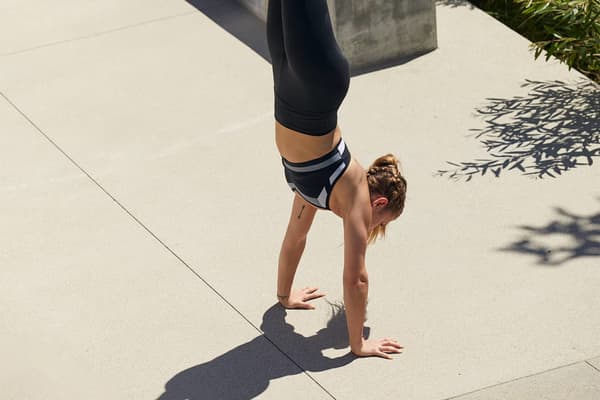The Beginner Guide to Tabata Workouts
Sport & Activity
Experts share the basics to master the four-minute HIIT workout and tips to create your at-home programme.

A workout doesn't have to be long to be effective. While the Centers for Disease Control and Prevention recommends 75 minutes of vigorous-intensity aerobic activity (think running, cycling or swimming) per week, research has suggested that brief (but intense) anaerobic, interval training can be just as effective for cardiometabolic health as longer bouts of traditional endurance training.
In other words, the length of your workout may not be as important as the effort you put into it, when it comes to working out for results. Cue Tabata workouts, which entail short but vigorous work all within a short timeframe. The best part? It's only four minutes long and it can be customised to tailor the needs of all fitness levels.
What is Tabata?
The Tabata workout was developed by Izumi Tabata, PhD and his team of researchers at the National Institute of Fitness and Sports in Japan. The four-minute workout, which is a form of high-intensity interval training, was first outlined in a study published in a 1996 issue of the Medicine & Science in Sports & Exercise. Participants were instructed to cycle through intense intervals on stationary bikes.
"The four minutes is divided into eight, 20-second rounds with 10 seconds of rest in between those rounds", said Alex Silver, a NASM-certified personal trainer. "Exercises can be either resistance-based or callisthenic exercises".
And there is plenty of research to support the positive effects engaging in short bursts of high-intensity exercise can have on overall health. A topical review on the benefits of low-volume HIIT workouts, found in a 2021 issue of the Journal of Physiology, suggested that a HIIT workout of less than 15 minutes can improve health markers (think: reduced blood pressure levels and improved cardiorespiratory fitness), similarly or at times better than a longer HIIT workouts.
What To Know Before Your First Tabata Workout
No matter your fitness level, you can try out a Tabata workout—it's relatively simple to modify for beginners. In fact, Kathy Glabicky, ACE-certified personal trainer recommended starting with a walking Tabata workout before building up to weights. If you're taking a class, she noted that you should feel empowered to notify the instructor that you're a beginner, as they can help make any necessary modifications.
"Beginners should start slow with lighter interval training and gradually work their way up to high intensity", Glabicky said. "Try 20 seconds on and 10 seconds off with easier exercises such as walking (versus sprinting) or low-impact moves using body weight. If you feel like you are getting breathless, extend your recovery times or add extra breaks".
Of course, you should always talk to your GP or physiotherapist before starting any exercise routine. Glabicky also stressed the importance of giving yourself time for a proper warm-up and cool-down period before and after engaging in Tabata workouts.
How Often Should You do Tabata Exercises?
How often you do a Tabata workout will depend on your fitness level. Silver said that once you are medically cleared, you can start to create a regular routine either by yourself or with the help of a personal trainer.
"I like to tell new clients that for the first few weeks they should adhere to a one to two ratio of one day of Tabata and two active rest days before the next HIIT programme", Silver said. "Once you start to gain momentum, flip-flop the numbers to two to one—eventually building the endurance to get to a five to two or six to one".
If you are looking for activities to do on active rest days, Glabicky suggested steady-state cardio such as yoga or stretching. And perhaps most importantly, you should be listening to your body and resting as needed.
(Related: 5 Benefits of Stretching Daily, According to Experts)
"Everyone recovers from exercise differently. Age, genetics, nutrition—there are many factors that come into play", Glabicky said. "You have to give your body adequate rest—from 24 to 48 hours—between intense workouts".
Additional Things To Know About Tabata Workouts
As is the case with any exercise programme, there are pros and cons to Tabata workouts. Silver said that if done correctly, a Tabata workout will be one of the toughest workouts you've ever done. Gaining a full understanding of the benefits and drawbacks can determine if the workout is right for you.
1.May improve both anaerobic and aerobic systems.
A review in a 2019 issue of the Journal of Physiological Sciences suggested Tabata improves both the aerobic and anaerobic energy systems in the body. These two systems provide different benefits to your athletic performance and overall health. Research has noted that aerobic (think: running, jumping and cycling) exercise supports cardiovascular endurance while anaerobic exercises (resistance training, core exercises, etc.) increases muscular strength and volume.
2.May be as effective as a longer HIIT workout.
As shown in the previously mentioned 2021 study in the Journal of Physiology, low-volume HIIT workouts have been found to be just as effective at boosting VO2 max (the maximum amount of oxygen your body can use while you workout) as their lengthier counterparts. They may even provide heart-health benefits.
3.Can be low-impact.
Even though Tabata is a form of HIIT, don't let the term "high-intensity" fool you. Glabicky said that the workout doesn't have to be high-impact, which can support beginners and make it more accessible to those with joint pain or injury.
"While high-impact moves like burpees and sprints are a great way to get your heart rate up quickly, your entire Tabata workout does not have to be filled with them", Glabicky said. "Low-impact moves using a dumbbell or bodyweight like a squat with a press and push-ups will do the trick if you are working hard".
Still, be sure to check in with your trainer, physiotherapist or GP to make sure this exercise is safe for you to do.
4.But can also be high-impact.
Silver noted that a Tabata workout can be done with bodyweight moves, but if you are using weights and racing the clock as opposed to going at your own pace, you may overexert yourself quickly.
10 Different Moves You May Find in a Tabata Workout
If you're ready to build your own Tabata workout and are wondering where to start, here are some moves that are typically used by experts. You can mix and match a combination of these moves to create your ideal Tabata workout at home.
- High-knees
- Plank punch
- Star jumps
- Side skaters
- Push-ups
- Burpees
- Mountain climbers
- Split squats
- Box jumps
- Lunges
Words by Ashley Lauretta














